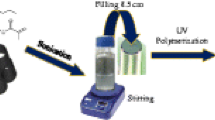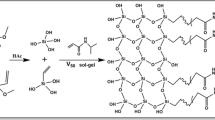Abstract
Short-term polymerization or the so-called low-conversion polymerization was applied for the preparation of N-vinylcarbazole (NVC) and 1,4-divinylbenzene (DVB) monolithic capillary columns. The synthesis was carried out by thermally initiated free radical copolymerization under the influence of inert micro- (toluene) and macroporogen (1-decanol) and α,α′-azoisobutyronitrile (AIBN) as radical initiator. The morphological and porous properties were studied by scanning electron microscopy (SEM), nitrogen adsorption, and mercury intrusion porosimetry (MIP). The copolymerization process was studied by monomer conversion measurements. This approach led to increased porosity and specific surface area. A specific surface area above 400 m2/g of the monolith and a distinct bimodal pore size distribution were obtained. The chromatographic performance was determined in terms of theoretical plate heights and number of theoretical plates. The lowest plate height value was found to be 3.9 μm (corresponding to ≈256,000 plates per meter) applying methylparaben utilizing an 80 mm × 0.2 mm i.d. monolithic capillary. The developed NVC/DVB monolithic supports showed high separation efficiency towards small molecules, which was exemplified applying reversed-phase (RP) separation of alkylbenzenes, beta-blockers, flavanoids, parabens, and phenones. The loading capacity was analyzed for isocratic separation of seven alkylbenzenes and was found to be up to 77 ng total mass of alkylbenzenes. Furthermore, a long-term stability test of 1,000 consecutive runs was performed and resulted in a maximum variance of 0.97, 0.85, and 0.16 % RSD for resolution, peak width at half height, and retention times, respectively. The material was proven to have a high permeability of 1.11E−14 m2, applying water as a mobile phase.










Similar content being viewed by others
References
Hjertén S, Liao J-L, Zhang R (1989) High-performance liquid chromatography on continuous polymer beds. J Chromatogr A 473:273–275
Svec F, Frechet JMJ (1992) Continuous rods of macroporous polymer as high-performance liquid chromatography separation media. Anal Chem 64:820–822
Svec F (2012) Quest for organic polymer-based monolithic columns affording enhanced efficiency in high performance liquid chromatography separations of small molecules in isocratic mode. J Chromatogr A 1228:250–262
Liu K, Aggarwal P, Lawson JS, Tolley HD, Lee ML (2013) Organic monoliths for high-performance reversed-phase liquid chromatography. J Sep Sci 36(17):2767–2781
Yu C, Xu M, Svec F, Fréchet JMJ (2002) Preparation of monolithic polymers with controlled porous properties for microfluidic chip applications using photoinitiated free-radical polymerization. Polym Sci Part A Polym Chem 40(6):755–769
Sinner FM, Buchmeiser MR (2000) Ring-opening metathesis polymerization: access to a new class of functionalized, monolithic stationary phases for liquid chromatography. Angew Chem Int Ed 39:1433–1436
Lämmerhofer M, Svec F, Fréchet JMJ, Lindner W (2000) Chiral monolithic columns for enantioselective capillary electrochromatography prepared by copolymerization of a monomer with quinidine functionality. 2. Effect of chromatographic conditions on the chiral separations. Anal Chem 72:4623–4628
Tennikova TB, Bleha M, Švec F, Almazova TV, Belenkii BG (1991) High-performance membrane chromatography of proteins, a novel method of protein separation. J Chromatogr A 555:97–107
Wang QC, Svec F, Frechet JMJ (1993) Macroporous polymeric stationary-phase rod as continuous separation medium for reversed-phase chromatography. Anal Chem 65:2243–2248
Wang QC, Švec F, Fréchet JMJ (1994) Reversed-phase chromatography of small molecules and peptides on a continuous rod of macroporous poly (styrene-co-divinylbenzene). J Chromatogr A 669:230–235
Meyers JJ, Liapis AI (1999) Network modeling of the convective flow and diffusion of molecules adsorbing in monoliths and in porous particles packed in a chromatographic column. J Chromatogr A 852:3–23
Gritti F, Piatkowski W, Guiochon G (2003) Study of the mass transfer kinetics in a monolithic column. J Chromatogr A 983:51–71
Oberacher H, Premstaller A, Huber CG (2004) Characterization of some physical and chromatographic properties of monolithic poly(styrene–co-divinylbenzene) columns. J Chromatogr A 1030:201–208
Minakuchi H, Nakanishi K, Soga N, Ishizuka N, Tanaka N (1996) Octadecylsilylated porous silica rods as separation media for reversed-phase liquid chromatography. Anal Chem 68:3498–3501
Tanaka N, Kobayashi H, Ishizuka N, Minakuchi H, Nakanishi K, Hosoya K, Ikegami T (2002) Monolithic silica columns for high-efficiency chromatographic separations. J Chromatogr A 965:35–49
Leinweber FC, Lubda D, Cabrera K, Tallarek U (2002) Characterization of silica-based monoliths with bimodal pore size distribution. Anal Chem 74:2470–2477
Oberacher H, Huber CG (2002) Capillary monoliths for the analysis of nucleic acids by high-performance liquid chromatography–electrospray ionization mass spectrometry. TrAC Trends Anal Chem 21:166–174
Ivanov AR, Zang L, Karger BL (2003) Low-attomole electrospray ionization MS and MS/MS analysis of protein tryptic digests using 20-μm-i.d. Polystyrene–divinylbenzene monolithic capillary columns. Anal Chem 75:5306–5316
Cabrera K, Lubda D, Eggenweiler HM, Minakuchi H, Nakanishi K (2000) A new monolithic-type HPLC column for fast separations. HRC J High Result Chromatogr 23:93–99
Trojer L, Bisjak CP, Wieder W, Bonn GK (2009) High capacity organic monoliths for the simultaneous application to biopolymer chromatography and the separation of small molecules. J Chromatogr A 1216:6303–6309
Greiderer A, Ligon SC, Huck CW, Bonn GK (2009) Monolithic poly(1,2-bis(p-vinylphenyl)ethane) capillary columns for simultaneous separation of low- and high-molecular-weight compounds. J Sep Sci 32:2510–2520
Greiderer A, Trojer L, Huck CW, Bonn GK (2009) Influence of the polymerisation time on the porous and chromatographic properties of monolithic poly(1,2-bis(p-vinylphenyl))ethane capillary columns. J Chromatogr A 1216:7747–7754
Urban J, Svec F, Fréchet JMJ (2010) Hypercrosslinking: new approach to porous polymer monolithic capillary columns with large surface area for the highly efficient separation of small molecules. J Chromatogr A 1217:8212–8221
Nischang I, Teasdale I, Brüggemann O (2010) Towards porous polymer monoliths for the efficient, retention-independent performance in the isocratic separation of small molecules by means of nano-liquid chromatography. J Chromatogr A 1217:7514–7522
Mohr J, Swart R, Huber C (2011) Morphology and efficiency of poly(styrene-co-divinylbenzene)-based monolithic capillary columns for the separation of small and large molecules. Anal Bioanal Chem 400:2391–2402
Kolarz BN, Wojaczyńska M, Pielichowski J (1991) Porous copolymers of N-vinylcarbazole and divinylbenzene. Angew Makromol Chem 192:27–34
Hamid MA, Naheed R, Fuzail M, Rehman E (1999) The effect of different diluents on the formation of N-vinylcarbazole-divinylbenzene copolymer beads. Eur Polym J 35:1799–1811
Gautam UG, Sawada T, Gautam MP, Takafuji M, Ihara H (2009) Poly(2-N-carbazolylethyl acrylate)-modified silica as a new polymeric stationary phase for reversed-phase high-performance liquid chromatography. J Chromatogr A 1216:7422–7426
Mallik A, Shingo K, Gautam U, Sawada T, Takafuji M, Ihara H (2010) Complete chromatographic separation of steroids, including 17α and 17β-estradiols, using a carbazole-based polymeric organic phase in both reversed and normal-phase HPLC. Anal Bioanal Chem 397:623–629
Koeck R, Bakry R, Tessadri R, Bonn GK (2013) Monolithic poly(N-vinylcarbazole-co-1,4-divinylbenzene) capillary columns for the separation of biomolecules. Analyst 138(17):5089–5098
Danquah MK, Forde GM (2008) Preparation of macroporous methacrylate monolithic material with convective flow properties for bioseparation: investigating the kinetics of pore formation and hydrodynamic performance. Chem Eng J 140(1–3):593–599
Lubbad SH, Buchmeiser MR (2009) Highly cross-linked polymeric capillary monoliths for the separation of low, medium, and high molecular weight analytes. J Sep Sci 32(15–16):2521–2529
Nevejans F, Verzele M (1985) Swelling propensity (Sp factor) of semirigid chromatographic packing materials. J Chromatogr 350(1):145–150
Engelhardt H, Arangio M, Lobert T (1997) A chromatographic test procedure for reversed-phase HPLC column evaluation. LC-GC 15(9):856–866
Siebert KJ (2006) Haze formation in beverages. LWT Food Sci Technol 39(9):987–994
Acknowledgments
The authors thank the Genome Research in Austria (GEN-AU) (Federal Ministry for Education, Science and Culture, Vienna, Austria) and SFB021 for financial support of the presented work. The authors would like to thank Thomas Bielz (Institute of Physical Chemistry, University of Innsbruck) for his support in interpreting nitrogen sorption data.
Author information
Authors and Affiliations
Corresponding author
Electronic supplementary material
Below is the link to the electronic supplementary material.
ESM 1
(PDF 11.7 kb)
Rights and permissions
About this article
Cite this article
Koeck, R., Fischnaller, M., Bakry, R. et al. Preparation and evaluation of monolithic poly(N-vinylcarbazole-co-1,4-divinylbenzene) capillary columns for the separation of small molecules. Anal Bioanal Chem 406, 5897–5907 (2014). https://doi.org/10.1007/s00216-014-8007-1
Received:
Revised:
Accepted:
Published:
Issue Date:
DOI: https://doi.org/10.1007/s00216-014-8007-1




